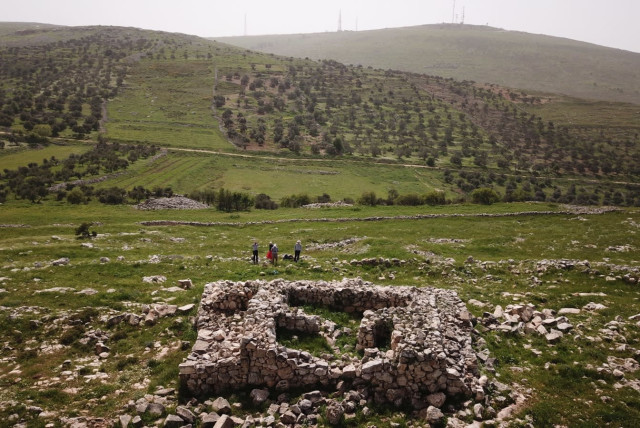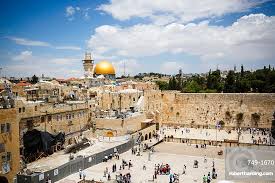By Caroline Glick

Two weeks ago, a bus filled with veteran Israeli generals from the Bithonistim, a grassroots national security organization, slowly made its way up the slopes of Mt. Ebal in Northern Samaria to visit a biblical-era site that was severely damaged by a Palestinian Authority contractor in late January.
They came to draw the public’s attention to the strategic implications of the war the Palestinians are waging against Jewish history.
The site was excavated between 1980 and 1989 by the late Professor Adam Zertal, who identified it as Joshua’s Altar as described in the Books of Deuteronomy, (27; 1-9) and Joshua (8; 30-35). The animal remains at the site contained thousands of burnt bones of year-old male, exclusively kosher, animals. They were burned in an open flame 3,250 years ago—the time generally identified as the period of ancient Jewish settlement of the Land of Israel under Joshua. Other remains found at the site included earrings and scarabs made in Egypt at the time of Ramses II, the Egyptian pharaoh often associated with the story of the Exodus from Egypt.
As Zertal explained in a lecture in 2013, the altar was buried under a layer of rocks, in keeping with Jewish prescriptions for preventing the desecration of abandoned holy sites. In keeping with the biblical narrative, the altar is made of unhewn stones; instead of steps, there are two ramps for the priests to alight to the platform—blocks of plaster were found nearby. The altar at Mt. Ebal also matches a Talmudic description of an altar from the Second Temple period, around 900 years later, indicating a continuity of Jewish practices throughout the biblical period.
Although initially controversial, Zertal’s general finding that the site is around 3,300 years old and is a Jewish historical site, where sacrifices were carried out in keeping with biblical guidelines, has become widely accepted—although many continue to dispute the specific identification with Joshua.
In late January, the Palestinian Authority (PA) posted a video on its website of 60 meters of the ancient wall surrounding the altar being destroyed to pave a road connecting the Palestinian village of Asira ash-Shamaliya to Nablus. Nablus, built on the ruins of the biblical city of Shechem, is located in northern Samaria between Mt. Ebal and Mt. Gerizim.
Zertal was a fiercely secular son of hardcore socialists. Yet, he explained in a 2013 lecture, his scientific work compelled him to accept that the biblical narrative “from Deuteronomy through the Books of Kings was historically accurate.”
“There are people who refuse to acknowledge that the damage done here was deliberate,” Major General Gershon Hacohen explained to Newsweek. “That since it was the surrounding wall—rather than the altar itself—that was destroyed, the altar wasn’t harmed. That’s like saying that if someone destroys the steps to the Acropolis, they aren’t harming the Acropolis. It’s the same complex.”
“They also say the Palestinians weren’t trying to damage the site—they just needed stones for their road. But look at this place,” he said and waved his hand across the landscape.
The slopes of Mt. Ebal are strewn with loose rocks.
“If they needed rocks for the road, all the Palestinians had to do was bring up a truck and take as many as they needed. Instead, they brought a bulldozer all the way up here and deliberately destroyed 60 meters of a 3,250-year-old wall.”
As if to prove Hacohen’s point, this week, a group of Palestinians was filmed barbecuing on the altar itself.
The Palestinian effort to destroy the site is of a piece with the PA’s long-standing efforts to destroy the physical record of millennia-old Jewish settlement in the Land of Israel. That effort is now focused on destroying and appropriating the artifacts of Jewish history in Samaria.
Just across the valley from Mt. Ebal is Tel Samaria, which contains the remains of the city of Samaria—the capital built by King Omri of the Northern Kingdom of Israel, where both Omri and King Ahab ruled.
During the Roman period, Herod built the city of Sebastia at Tel Samaria and turned it into one of the most important cities in ancient Israel.
In November 2020, the PA held a ceremony at Sebastia in which Prime Minister Mohammad Shtayyeh proclaimed it a “Palestinian heritage site” and foisted a massive Palestine Liberation Organization (PLO) flag up a 15-meter flagpole.
The Palestinians claim Herod, known as “the King of the Jews”—the ruler who expanded the Jewish Second Temple complex in Jerusalem in the first century B.C.E.—was actually “the King of Palestine.”
The PA is also destroying the nearby archaeological site of Tel Aroma, a center of Jewish settlement for more than a millennium.
Since the PLO founded the PA in 1994 in the framework of its peace process with Israel, destroying and appropriating Jewish historical sites—with the enthusiastic support of international organizations like UNESCO—has been a constant effort.
Immediately after Israel transferred control over the city of Jericho to the PA in 1994, then-PLO leader Yasser Arafat directed the destruction of the ancient Shalom al Yisrael synagogue in Jericho.
But the central focus of its destructive activities has been the Temple Mount.

In 1999, the PA carried out a massive renovation project to transform ancient underground Temple Mount chambers into a new mosque, removing 9,000 tons of antiquities and debris from the complex and dumping them around Jerusalem. Alarmed archaeologists collected the debris and transferred it to Mt. Scopus, where the Temple Mount Sifting Project was inaugurated. Over the next 20 years, thousands of artifacts were discovered by volunteers who sifted through the garbage to salvage them.
Last year, the PA plundered Hasmonean graves at the Hasmonean palace outside Jericho and scattered 2,000-year-old bones.
UNESCO, the UN agency charged with preserving international heritage sites, has supported the Palestinian efforts, denied the Jewish ties to the Temple Mount—Judaism’s most sacred site—and declared the Cave of Machpela in Hebron—where the biblical patriarchs and matriarchs are buried—an Islamic heritage site, along with Rachel’s Tomb in Bethlehem.
The PLO and the PA have never agreed to recognize that Israel is the Jewish state. Since the PLO published its charter in 1964, the consistent Palestinian position has been to deny that the Jews have any history at all in the Land of Israel. An internal memo from the PLO’s negotiations support unit explained why. Published in 2011 by The Guardian and Al Jazeera, it warned, “Recognition of the Jewish people and their right to self-determination may lend credence to the Jewish people’s claim to all of Historic Palestine.”
In other words, the obliteration of the historical record is a fundamental feature of the Palestinian war to destroy Israel. Any acknowledgement of Jewish history in the Land of Israel risks revealing the otherwise-undeniable truth that the Jewish people are indigenous to the Land of Israel.
Arafat’s successor, PLO and PA chief Mahmoud Abbas, as well as all of his colleagues, live by these lies. Abbas has rewritten thousands of years of history to claim a 5,000-year history in the Land of Israel for the Palestinians. He alternates between claiming lineage from the Jebusites and Canaanites, while denying that there was ever a Jewish Temple in Jerusalem.
Benny Katzover, who served as Samaria Regional Council chairman during Zertal’s excavation, became close friends with Zertal during his long years of work. Speaking to the generals, Katzover said, “No nation would allow anyone to destroy its roots in this fashion. We, the Jewish people, have the deepest, most significant roots in our land of all of humanity. It isn’t a surprise that the entire world is trying to deny these ties, by turning a blind eye to the destruction and claiming that the Cave of Machpela is a Palestinian heritage site.”
Hacohen responded by recalling an interview from 2009 with Abbas Zaki, the PLO’s ambassador to Lebanon, in which Zaki revealed the PLO’s true purpose when it calls for a so-called “two-state solution” that would require Israel to withdraw from Judea and Samaria and northern, eastern and southern Jerusalem, including the Temple Mount.
“With the two-state solution,” Zaki said, “Israel will collapse, because if they get out of Jerusalem, what will become of all the talk about the Promised Land and the Chosen People? What will become of all the sacrifices they made—just to be told to leave? They consider Jerusalem to have a spiritual status. The Jews consider Judea and Samaria to be their historic dream. If the Jews leave those places, the Zionist idea will begin to collapse. It will regress of its own accord. Then we will move forward.”
In other words, the purpose of the Palestinian war against, and appropriation of, Jewish history in the Land of Israel is to set the conditions for Israel’s ultimate physical destruction. Where better to strike than the site where, in Moses’s words, the Jews became “the nation of the Lord your God?”
Originally published in Newsweek.



Where are the Il Gvt, the archeological authorities and IDF?
Any role from the EU?
There is no difference between the Palestinian Authority (PA) and ISIS. They should be treated the same.
Black Lives Matter and Antifa, here in the US, now have good role models in the PA and ISIS.